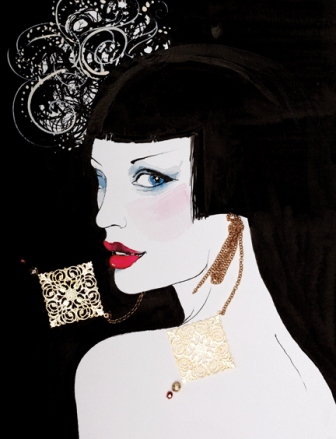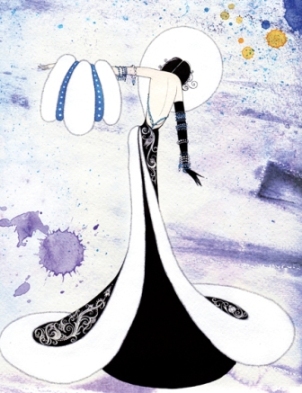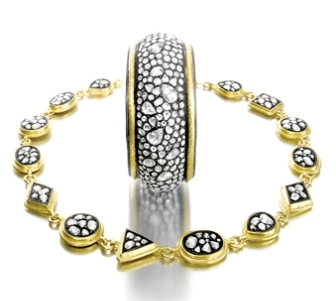The Greatest Compliment Of All
March 01, 10
According to the biblical book of Ecclesiastes, there is nothing new under the sun. Old films inspire new movies, beloved songs are reinterpreted by new generation of singers and well-known works of art beget new canvases. The world of fashion works according to the same principles – and then some.
But in fashion another process is at work. Retailers have long known that consumers hanker after celebrities. They want to know everything about them and they want to be like them, which is why celebrity-oriented magazines all carry features showing readers how to dress like their favorite stars.
“Celebrities have always had a large impact on the way people buy, but it seems to be getting bigger every year. The obsession with celebrities seems to be increasing. [Celebrity-related] business seems to be propelled further and further and faster and faster every year,” says Taylor Barnett, CEO of FantasyJewelryBox.com, an Internet-only company that sells celebrity-inspired jewelry.
But it is not only clothing retailers that are taking the concept of celebrity-inspired fashion off the red carpet and into the hands of consumers in record speed, some jewelry retailers are doing it too and as they know all too well, there is a thin line between “inspired by” and copying.
Celebrity Silver LLC is based in San Francisco, California and according to its CEO, Adam Babish, can develop products in as little as 14 days, with product discovery and testing taking the longest time. “Our development team is always working on a project,” he explains. “When we see a celebrity in a magazine or on the big screen with an item we love, we first decide on a style layout and create a prototype. Once we are happy with the prototype, we can start full production, as well as a marketing and advertising campaign about the new piece.”
| |
There is always a danger of copyright issues when it comes to too closely copying preexisting designs, Babish, however, says that the company takes a number of steps to prevent entering into any grey areas. “Many of our pieces are inspired from celebrities’ styles of jewelry, be they rings, necklaces, bracelets or earrings, however, we never use any type of other companies’ name branding and we often try to make the product unique enough to call it our own,” he says. “Additionally, we never imply that any product we offer is endorsed or sold on behalf of any brand or celebrity.”
When it comes to selling imitation jewelry, FantasyJewelryBox.com is extremely careful not to make exact copies of the pieces seen on the red carpet or at awards events. “We have to be careful not to use the exact style that designers are using. We respect the rights of the designer,” says Barnett.
The company obtains its jewelry in one of two ways. Either it sources pre-existing jewelry that meets its current demands, or it designs the jewelry from scratch using manufacturers in
The process from concept to sale takes anywhere between six to eight weeks depending on the complexity of the piece. “The first thing we do is check with the manufacturers to see if they have a piece already designed. If not, we have to create it,” says Barnett. “We begin with an original photo or a detailed sketch. The manufacturers use that to make a sample, which takes about three weeks for us to receive it. Once we have it, we inspect it to make sure the quality is up to par. Once we okay it, it goes into production, which takes a further four to five weeks before we have it ready to ship to the consumers. “
While he would not reveal which celebrity pieces propel the most sales, Babish says that the company tends to focus on celebs who are what he terms on the cusp of fashion trends. “We are always looking for new and unique designs [that we find by looking at] the celebs who aren’t afraid to mix it up.”
Barnett on the other hand is quick to point to Angelina Jolie as a celebrity fashion leader. “She is always glamorous and gets lots of attention.” He cites replicas of the emerald earrings she wore to the Oscars in 2009 as a big seller. “She made such a big fashion impact wearing those earrings. Our version is much smaller and scaled down. They are something that a woman could realistically wear, but still make a big statement with,” he says.
Jennifer Aniston also drives trends, says Barnett, but the most popular celebrity changes all the time depending on who is in the news, who has a new premier, who just attended an awards show or who is doing something controversial.
Another obvious point of inspiration is the big celebrity events such as the Golden Globes or the Oscars. “These types of events are the lifeblood of the market we are in,” explains Babish. “”Not only do they draw new customers into our site, but they also allow us to see exactly what trends are hitting, missing and are just plain ridiculous.”
Barnett agrees. “Red carpet events have a large impact in the week or the couple of weeks following the event. There is a lot of consumer interest and the trends and fashion is all over the news. There is renewed interest from consumers looking for something new and fashionable to wear. It gives us a big push as far as traffic and sales are concerned.”
The major difference between what consumers see on the red carpet and what they themselves can buy all comes down to materials, of course. Celebrity Silver makes all of its jewelry from sterling silver, rhodium, vermeil (a 14 karat gold plating over sterling silver) and different shades and colors of simulated cubic zirconia. “For the most part, our customer base would never be able to afford a 3+ carat celebrity style diamond ring, which could range in price between $250,000 to over $1 million,” says Babish. “However, we were able to produce simulated CZ diamonds that were flawless and to the naked eye would be very hard, if not impossible to distinguish [from a diamond], at a fraction of the price of the [jewelry] worn by a celebrity.
| |
While some may look down on the “inspired by” market as being nothing more than cheap imitations, those doing the buying think otherwise. “We have seen aggressive growth within the last three years and the expansion to the Internet a few years back continues to create a lot of viral press as well as sales for our organization,” says Babish, who confirms that the market is a growing one, helped by the increased acceptance of shopping on the Internet.
“We are still a ‘mom and pop’ shop with only a few hired hands, but we love the ‘hands on’ approach this setup provides, he says of Celebrity Silver specifically. “We are very excited for 2010 and believe this is going to be the greatest year yet.”
Both Babish and Barnett cite the recent downturn in the economy as part of the reason for the increased success of this type of jewelry. “Women are always going to want to look great,” says Babish. “But when hard times come along, the monthly budget for apparel and accessories shrinks. Shopping with Celebrity Silver allows them to keep more of their hard-earned money all the while keeping their friends guessing how they could afford such expensive looking jewelry.”
Barnett concurs. “People have shifted away from gold and diamonds. They are having to scale back. They still want to look good but they can’t necessarily afford to spend hundreds of dollars on a piece of jewelry. They are looking to sterling silver and are still achieving a high-end look at a fraction of the price.”
Located at the other end of the scale is designer extraordinaire Yossi Harari. The Israeli jewelry designer is a common fixture on the celebrity circuit. His pieces have adorned some of the most famous names of our time. A certain Oprah Winfrey is a devotee of Harari’s jewelry, which carries an average price tag of between $5,000 and $15,000, with some pieces going in excess of $150,000. “She loves my pieces,” says Harari of Winfrey. “She buys them and wears them constantly. It’s really flattering,” he says.
Other famous fans include actresses Cameron Diaz and Kate Hudson, supermodel Cindy Crawford and actress, model and designer Elizabeth Hurley who used Harari’s jewelry to accessorize the catalog she shot for her bathing suit collection.
While Harari does not design pieces specifically for the red carpet, he says the celebrity following has certainly strengthened his brand and his business. “It gives the brand credibility. With all due respect, the red carpet is the place for people show the best of the best. It’s wonderful to be chosen so often.“
Since Harari is a high-end and highly visible designer, he admits he has had his share of people copying his designs, but he takes these imitators into his stride. “I will repeat what Coco Chanel was said on the subject. She said ‘The day they stop copying you is the day you are in trouble.’ I take it as a compliment that people want to copy my designs. It means I did something impressive and special. I have so many ideas they will always have something to copy,” he jokes.
As for why people want to copy celebrities, Harari says that celebrities are the supermodels of trend setting. “Those people who can afford to buy what the celebrities are wearing move closer to them, at least psychologically,” he says. “People want to touch the glitter and fame of
| |
When the Going Gets Tough, the Buyers Buy Down
While purveyors of “imitation” jewelry may be citing the economic downturn as a reason for any sales increase they are seeing, research by IDEX Online analyst Ken Gassman shows that the recent recession did not stop many people buying diamond jewelry.
What did happen, however, is that consumers coming into the jewelry stores “bought down.” This means, rather than buying a 4 carat diamond, they shopped down and instead opted for a smaller stone. The IDEX Online polished diamond prices index attests to this phenomenon. In December 2009, sales of 3 carat stones and smaller posted solid month-over-month gains. In contrast, larger diamonds – 4 carat and higher – fell in price in December versus November 2009. According to Gassman, this confirmed retailers’ reports that smaller, lower-cost diamonds were selling better than larger, high-cost stones.
When the going gets tough, there is no doubt that consumers change their buying behavior, but those who were going to buy diamonds – for engagement or wedding jewelry for example – are not going to change their mind, what they will change, however, is the size of diamond they buy.


